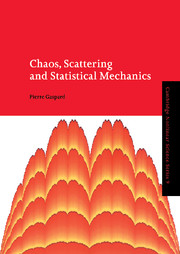Book contents
- Frontmatter
- Contents
- Preface
- Introduction
- Chapter 1 Dynamical systems and their linear stability
- Chapter 2 Topological chaos
- Chapter 3 Liouvillian dynamics
- Chapter 4 Probabilistic chaos
- Chapter 5 Chaotic scattering
- Chapter 6 Scattering theory of transport
- Chapter 7 Hydrodynamic modes of diffusion
- Chapter 8 Systems maintained out of equilibrium
- Chapter 9 Noises as microscopic chaos
- Chapter 10 Conclusions and perspectives
- References
- Index
Chapter 7 - Hydrodynamic modes of diffusion
Published online by Cambridge University Press: 30 January 2010
- Frontmatter
- Contents
- Preface
- Introduction
- Chapter 1 Dynamical systems and their linear stability
- Chapter 2 Topological chaos
- Chapter 3 Liouvillian dynamics
- Chapter 4 Probabilistic chaos
- Chapter 5 Chaotic scattering
- Chapter 6 Scattering theory of transport
- Chapter 7 Hydrodynamic modes of diffusion
- Chapter 8 Systems maintained out of equilibrium
- Chapter 9 Noises as microscopic chaos
- Chapter 10 Conclusions and perspectives
- References
- Index
Summary
Hydrodynamics from Liouvillian dynamics
Historical background and motivation
Hydrodynamics describes the macroscopic dynamics of fluids in terms of Navier–Stokes equations, the diffusion equation, and other phenomenological equations for the mass density, the fluid velocity and temperature, or for chemical concentrations. In nonequilibrium statistical mechanics, these phenomenological equations may be derived from a kinetic equation like the famous Boltzmann equation or other master equations describing the time evolution at the level of one-body distribution functions (Balescu 1975, Résibois and De Leener 1977, Boon and Yip 1980). The kinetic equation itself is derived from Liouvillian dynamics using a Markovian approximation such as Boltzmann's Stosszahlansatz. Such approximations may be justified in some scaling limits for dilute fluids or other systems, but the derivation of hydrodynamics is not carried out directly from the Liouvillian dynamics. The only direct link between hydrodynamics and the Liouvillian dynamics – which is used in particular in molecular-dynamics simulations – is established in terms of the Green–Kubo relations.
The recent works in dynamical systems theory have shown that further direct links are possible. In particular, we have observed with the multibaker map in Chapter 6 that the spectrum of the Pollicott–Ruelle resonances actually provides the spectrum of the phenomenological diffusion equation in spatially extended systems (Gaspard 1992a, 1995, 1996). This result suggests that the dispersion relations of hydrodynamics can be obtained in terms of the Pollicott– Ruelle resonances and that the hydrodynamic modes can be constructed as the associated eigenstates.
- Type
- Chapter
- Information
- Chaos, Scattering and Statistical Mechanics , pp. 275 - 342Publisher: Cambridge University PressPrint publication year: 1998

